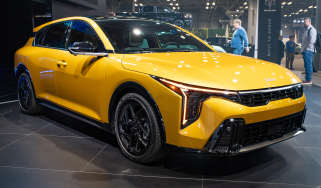Peugeot 207 1.4 S
The new 207 retains the look of the model it succeeds, although it’s marked out by bold bumpers and a gaping grille
Why change a winning formula? That’s the question top brass at Peugeot were asking themselves when they started developing a replacement for the successful 206. The new 207 retains the look of the model it succeeds, although it’s marked out by bold bumpers and a gaping grille.
It’s the longest of our five contenders – indeed, as with the Corsa, the Peugeot has grown considerably. Yet despite having a wheelbase 29mm greater than the Vauxhall’s, the 207 doesn’t offer as much leg or headroom in the back. Its rear windows are tiny – as is the case on the Corsa – but the 207 has a tighter roofline, so it’s the French car that feels more claustrophobic in the rear.
Video: watch CarBuyer's video review of the Peugeot 207
[[{"type":"media","view_mode":"content_narrow","fid":"69208","attributes":{"alt":"","class":"media-image"}}]]
The boot also disappoints – its 270-litre capacity is the smallest on test – yet things improve up front. Providing a wide range of steering wheel movement and superb seats, the 207 has the best driving position, while visibility is good, too.
What’s more, the dashboard layout is smart; the upper section is stylishly designed and feels solidly put together, although some of the plastics used lower down in the cabin are less impressive. Interior stowage is poor, with half the glovebox lost because Peugeot didn’t swap the fusebox over in the transition from left to right-hand drive. The cheap-looking heater controls are another prominent example of cost-cutting, and this takes the edge off the feelgood factor. As a result, the 207’s cockpit can’t match the quality of the Corsa’s or the individuality of the Clio’s.
Used - available now

2022 Nissan
Micra
22,169 milesManualPetrol1.0L
Cash £10,700
2015 Volvo
S60
78,200 milesManualPetrol1.6L
Cash £7,400
2016 Tesla
Model S
78,000 milesAutomaticElectric
Cash £18,999
2019 Nissan
Micra
17,450 milesAutomaticPetrol1.0L
Cash £13,199Still, if there’s one thing Peugeot has always got right, it’s making its small cars fun to drive. The 207 offers lots of grip and is nicely balanced when cornering. Body roll is well controlled, and although it rides harder than the Clio, it isn’t quite as firm as the Corsa SXi.
The steering has a nice feel and offers the sharpest turn-in of all five cars in this test. It’s just a shame the five-speed gearbox has such a vague and flimsy shift action – this is one legacy from the 206 that the 207 could do without, as it spoils the whole driving experience.
The 1.4-litre engine is also carried over from the old car, and it shows. It’s short on refinement and becomes strained high in the rev range. Delivering 90bhp, it’s 1bhp up on the Corsa, but trails the Clio by 8bhp. As a result, the 207 is 1.5 seconds behind the Renault in the 0-60mph sprint. Yet the Peugeot has the most torque, at 133Nm, which translates into impressive in-gear pace.
But this isn’t matched by its ability to stop. Although the middle pedal feels good underfoot, the brakes took 39.5 metres to bring the 207 to a halt from 60mph – that’s the longest here. And while the car proved comfortable over distances, it was noisier than the Clio and Corsa at 30 and 70mph. It’s simply not as well insulated or built.
The 207 scores well on safety, though. It achieved a five-star Euro NCAP crash test rating, picking up more points overall than the Renault.
Our £10,295 A/C S model is cheaper than the Corsa and Clio, but alloys and front foglamps are missing from the kit list. Go for the £10,895 Sport, though, and they are standard. As with the Corsa and Clio, stability control is an option, yet Peugeot charges £100 more for it than Vauxhall, at £350.
Attractive to look at and entertaining to drive, the 207 has lots to offer. But the gearbox, engine and rear cabin space count against it here.
Details
Price: £10,295
Model tested: Peugeot 207 S 1.4
Chart position: 3
WHY: The new 207 is available in three or five-door bodystyles, and there’s a choice of six trim levels. Five engines are offered: two petrol powerplants and three diesels. In this test, we drive a 1.4-litre S fitted with air-conditioning – and at £10,295, the Peugeot is one of the cheapest cars in our line-up.
Economy
The differences in this class are small, and we averaged 34.7mpg – 1.1mpg more than the Corsa. But a five-litre bigger tank gives the French hatch 49 miles of extra range.
Residuals
With a retained value of 45.5 per cent, the 207 is the second strongest performer. It should be worth £4,684 in three years’ time – £408 more than the Clio.
Servicing
While the Peugeot is the most costly car to service, checks are needed only every 20,000 miles. But the firm’s dealers came 31st out of 33 in our 2006 Driver Power satisfaction survey.







